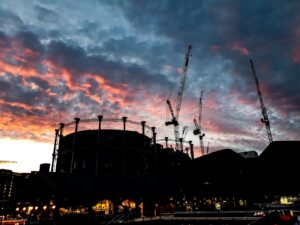In wake of the Grenfell tragedy, a leading Architect has claimed construction experts are now cautious about switching to using sustainable building materials like engineered timber.
Andrew Waugh of Waugh Thistleton Architects, which is at the forefront of eco-building design – has informed Sky News that the construction industry and regulators are too cautious about using sustainable materials in tall structures – even though the catastrophe occurred in a concrete tower.
In June 2017, a high-rise fire broke out in the 24-storey Grenfell Tower block of flats in North Kensington, West London, and burned for 60 hours killing 72 people.
According to the World Green Building Council, which catalyses the uptake of sustainable and decarbonised built environments for everyone, buildings are currently responsible for 39% of global energy related carbon emissions.
28% of emissions come from operational uses, form energy needed to heat, cool and power them, and the remaining 11% from materials and construction.
Research also displays that cement alone accounts for 8% of carbon emissions, however materials such as wood are higher. It is reported that 1kg of wood contains around 450 to 500 gm of carbon. This means 1kg of wood is holding about 1.65 to 1.80kg of CO2.
However, Mr Waugh is suggesting more construction experts should make the shift onto using engineered timber because if the material is intact and doesn’t rot or burn, the carbon is stored long-term.
Speaking to Sky News, Mr Waugh said: ‘[The UK] were the innovators of this material before Grenfell happened.
‘Now we have a situation where the rest of the world are changing their building regulations, changing their planning laws and government procurement for housing, hospitals and schools to promote the use of timber.’
The material of engineered timber has cast a divide between experts opinions on using it – some believe the exterior surface only chars – partially burn so as to blacken the surface – leaving the structural core intact.
However, a fire safety researcher from Edinburgh University said charring still releases combustible gases and claims more research on the material needs to be completed.
In a bid to promote the use of the sustainable material, Mr Waugh designed the UK’s tallest office block, which is situated in London, constructed from engineered timber. The columns and beams for the building are made from cross-laminated timber – layers of wood that have been glued together at different angles – making them stronger than concrete and lighter than steel.
Photo by Conor Brown
















Leave a Reply